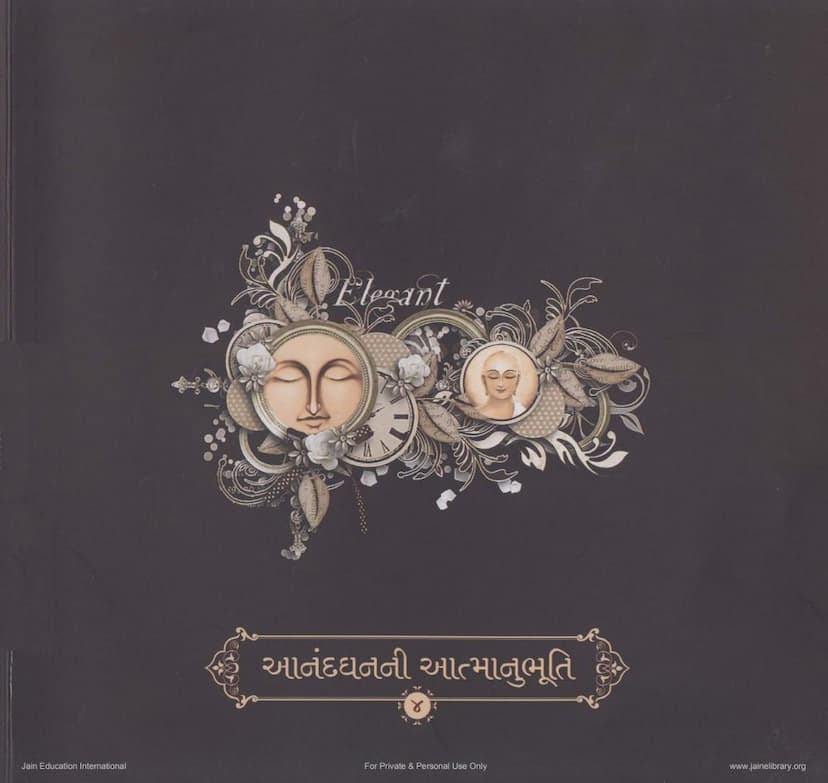Anandghan Ni Atmanubhuti 04
Added to library: September 1, 2025

Summary
Here's a comprehensive summary of the provided Jain text, "Anandghan ni Atmanubhuti 04," focusing on its core themes and spiritual message:
Book Title: Anandghan ni Atmanubhuti 04 Author: Kalyanbodhivijay (Commentary/Elaboration) Original Work: Anandghanji Maharaj (Fourth spiritual verse) Publisher: Shri Jinshasan Aradhana Trust
Overall Theme:
This text is a commentary and detailed exploration of the fourth spiritual verse (pad) composed by the renowned Jain mystic, Anandghanji Maharaj. The central theme revolves around Atmanubhuti (Self-realization or Experiencing the Self) through the profound path of Preeti (Love). It emphasizes that true and lasting spiritual fulfillment comes not from external pursuits, but from cultivating an unconditional, intrinsic love for one's own soul.
Key Concepts and Explanations:
-
The Awakening of Love for the Self: The verse begins with "Suhaagan! Jaagi Anubhav Preet" (O Virtuous one! Love for experience has awakened). This signifies the crucial moment when an individual's deep-seated love shifts from external objects or desires to their own true spiritual nature. This awakening dispels the "anadi agyan" (primordial ignorance).
-
The Nature of True Love (Nirupadhik Preeti):
- The text heavily contrasts "Upadhik Preeti" (Conditional Love) with "Nirupadhik Preeti" (Unconditional Love).
- Conditional Love is based on external factors like physical beauty, wealth, status, or even pleasing words. It is transient and perishes when the external condition is removed. Examples are given of marriages breaking due to loss of beauty or financial ruin. This type of love is compared to drinking impure water instead of pure nectar.
- Unconditional Love is intrinsic, arising from the inherent nature of the beloved, without any external cause or condition. It is pure, selfless, and eternal. This is the kind of love one should cultivate for the soul.
-
The Soul as "Suhaagan" (The Auspicious Bride):
- The term "Suhaagan" (a woman whose husband is alive, symbolizing auspiciousness and completeness) is used to describe the soul that has achieved Atmanubhuti.
- The commentary explains this through the concept of "Dravya-Aastik Naya" (Substance-based perspective) and "Paryaya-Aastik Naya" (State/Modality-based perspective). While the soul is eternally substantial (Dravya), its experiential states (Paryaya) can experience "death" through the loss of "Bhavapranas" (spiritual life-force: right faith, knowledge, conduct).
- When the soul experiences unconditional love for itself, it achieves a state of spiritual "marriage" (Parinay-Shubh Vivah) with its pure consciousness, making it eternally "Suhaagan." This means the soul's pure state is now permanently "married" to its inherent blissful nature, and cannot become "widowed" by ignorance.
-
The Lamp of Self-Knowledge (Bhed-Vigyan):
- The text uses the metaphor of a lamp ("Deepak") to represent "Bhed-Vigyan" (Discriminating Knowledge, or the knowledge that distinguishes the self from non-self).
- This lamp is described as:
- Sahaj (Natural/Effortless): Unlike earthly lamps requiring wicks, oil, and effort, this inner lamp of self-knowledge is inherent.
- Sujyoti Swaroop (Embodiment of Pure Radiance): It is a radiant light that illuminates without external dependence.
- Anupam (Incomparable): It is unique and cannot be compared to any external light.
- This discriminating knowledge is the foundation of Atmanubhuti. Without it, the distinction between self and non-self remains blurred, leading to attachment and bondage. When this inner lamp is lit, ignorance ("Andhkar") automatically vanishes, just as darkness disappears when light appears.
-
The Uniqueness and Inexpressibility of Atmanubhuti:
- The verses express the profound difficulty, and indeed impossibility, of fully articulating the experience of Atmanubhuti through words.
- Metaphors like the sweet Gulab Jamun are used: one can describe its sweetness and deliciousness, but the actual taste can only be experienced. Similarly, while scriptures and teachings can point the way, the actual realization is an internal, direct experience.
- The author uses phrases like "Kahan dikhavu aur ku? Kahan samjau bhor?" (How can I show it to others? How can I explain it to the innocent?) and "Anandghan Prabhu prem ki, akath kahani koy" (The love of Lord Anandghan is an untold story).
- This ineffability is a hallmark of true spiritual experience, which transcends the limitations of language and intellect.
-
The Unfailing Arrow of Love:
- The verse "Teer achook hai prem ka, laage so rahe thor" (The arrow of love is unfailing; whoever it strikes, remains steadfast) is central.
- This "love" refers to the love for the Self (Atmanubhuti). When this love strikes the soul, it becomes steadfast and unwavering in its true nature.
- It draws parallels to the intense focus of a deer mesmerized by music, which ignores danger. Similarly, true love for the Self makes one indifferent to worldly attachments and pleasures, rendering them insignificant like a blade of grass.
- This love anchors the soul, leading to stability and eventually spiritual prosperity.
-
Moving from Love to Experience:
- The commentary encourages the reader to follow the path laid out by Anandghanji, letting love for the Self lead them towards direct experience.
- It highlights that true love is not about receiving or reciprocity but a pure, selfless devotion. This is exemplified by the story of Radha and Krishna, where Radha's love is so profound that Krishna's tears are shed for her, and her only wish is for Krishna not to be distressed. This selfless love is the essence of devotion to the divine within.
In Essence:
"Anandghan ni Atmanubhuti 04" is a spiritual guide that calls readers to awaken an unconditional love for their own soul. It teaches that this intrinsic love, free from all external dependencies and attachments, is the key to dispelling ignorance, achieving a permanent state of spiritual well-being ("Suhaagan"), and experiencing the ineffable bliss of Atmanubhuti. The text uses powerful metaphors and spiritual insights to illuminate this profound journey from conditioned affection to the pure, steadfast love of the Self.